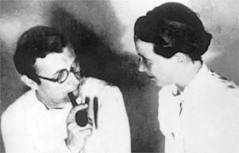 The last stop of my visit to Paris exploring the old haunts of the French philosophers is the Sorbonne. A beautiful and ancient large sandstone building, it dominates the Latin Quarter’s bustling urban terrain of cafés, bookshops and boutiques.
The last stop of my visit to Paris exploring the old haunts of the French philosophers is the Sorbonne. A beautiful and ancient large sandstone building, it dominates the Latin Quarter’s bustling urban terrain of cafés, bookshops and boutiques.
My daughter Alex and I first spot it while riding northwards towards the Seine on the wide arterial of St Michel Boulevard, along with Paris’s other peak hour traffic of motor scooters, bicycles, Citroens, Peugeots and pedestrians. We gasp at the sight of it rising up to our right, its majestic features brought into spectacular contrast by the rays of the setting sun.
Simone de Beauvoir was a student at this venerable institution in 1929 when she met Jean-Paul Sartre. It was here that she studied for and passed the agrégation, the highly competitive national examinations in philosophy. Passing this entitled her to lifelong tenure teaching philosophy in France’s high schools. By 1943, however, she had managed to lose this privilege in scandalous circumstances when a parent complained she and her partner Jean-Paul Sartre had both seduced their teenage daughter while she was Beauvoir’s student. Beauvoir and Sartre had got away with such behaviour previously with other students, but on this occasion it led to Beauvoir having her teaching licence permanently revoked. This sanction didn’t have much of a negative impact on Beauvoir’s life, however, as by this time she had had developed a considerable reputation as a writer and as Jean-Paul Sartre’s celebrity partner and co-spokesperson for the new philosophy of existentialism.
The Sorbonne, founded in the mid-12th century, was one of the very first universities to be established in Europe, and has been a centre of intellectual activity in Paris ever since.
More recently, the Sorbonne was the central stage for the notorious uprisings that brought Paris to a standstill in May 1968. These protests, which began with students occupying the Sorbonne’s buildings in response to government policies about university administration, spread like wildfire amongst other students, teachers and workers throughout France culminating in a general strike of a staggering ten million workers. Throughout the weeks of civil disorder that took France to the brink of collapse, the Sorbonne became a battleground for bitter hand-to-hand fighting between students and riot police. Makeshift barricades of furniture, cars and street debris were erected by the Left Bank’s protesting students just as they had been in the French Revolution two hundred years earlier. For several days, the whole country held its breath, fearful of a another revolution, until eventually a very rattled President de Gaulle accepted the resignation of his Prime Minister Georges Pompidou and called for a general election, finally diffusing the mutinous mood in the streets.
Today, my hopes of exploring the interior of this venerable institution are frustrated by a uniformed security officer guarding the entrance. So I resign myself to taking in the view from the outside as a steady stream of students and teachers come in and out. In front of the building, the Place de la Sorbonne — a large busy square open to the public — is abuzz with young students milling among its sidewalk cafés and bookshops. A sign that says Libraire Philosophie announces a bookshop devoted solely to philosophical texts, a sight I have seen more than once on this trip to Paris but never in my home country of Australia. The bookstore appears to be connected with the university, as it has a poster announcing the Sorbonne’s philosophical courses and the associated recommended reading. The philosophy of Sartre and his philosophical predecessor Martin Heidegger feature heavily. Phenomenology and existentialism still appear to be fashionable in this part of town.
A sign that says Libraire Philosophie announces a bookshop devoted solely to philosophical texts, a sight I have seen more than once on this trip to Paris but never in my home country of Australia. The bookstore appears to be connected with the university, as it has a poster announcing the Sorbonne’s philosophical courses and the associated recommended reading. The philosophy of Sartre and his philosophical predecessor Martin Heidegger feature heavily. Phenomenology and existentialism still appear to be fashionable in this part of town.
As I bask in the beauty of this glorious building and its changing colours in the fading sunset, it occurs to me that all the places in which Sartre and Beauvoir studied, wrote, dined, drank, conversed and made love during their years as Paris’s favourite intellectuals are within walking distance of this square. They were even buried only a stroll away in the Cimetière Montparnasse.
In front of the aforementioned bookshop, I catch sight of two young lovers deep in an embrace. I imagine that Sartre and Beauvoir would have sometimes met in this exact place during the heady early days of their lifelong love affair.
I imagine that Sartre and Beauvoir would have sometimes met in this exact place during the heady early days of their lifelong love affair.
I grab my camera, thinking the scene before me might just be a perfect cover for the book I have recently finished writing – Lovers of Philosophy – about the love lives of Sartre and other influential European thinkers.
I wonder, as I capture these two paramours on film outside the philosophy bookshop, could they be a Jean-Paul Sartre and Simone de Beauvoir of the future?










